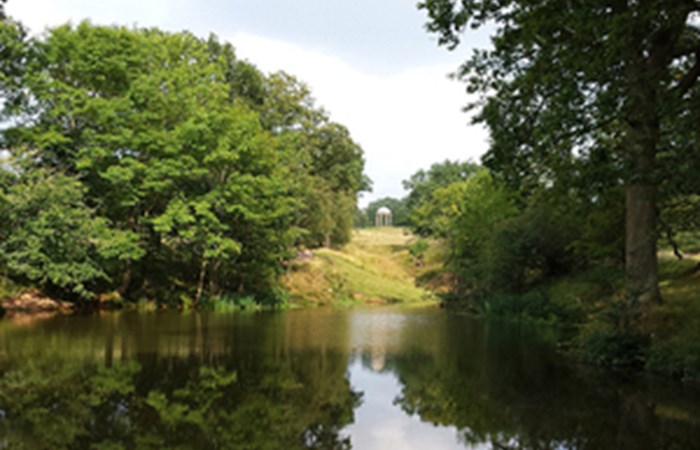Natural England

Work supported by Natural England at Hagley Park in Worcestershire is shortlisted for one of English Heritages prestigious Angel Awards.
Its just one of a number of projects where Natural England has been working with heritage bodies to safeguard some of our most vulnerable built heritage. These include a number of projects highlighted in English Heritages latest Heritage at Risk Register.
The 2014 register is the most comprehensive so far, with listed buildings, places of worship, industrial sites, scheduled monuments, parks and gardens, ship wrecks and battlefields identified as at risk.
Although English Heritage has added many new sites in need of rescue to the register, there are still plenty of success stories to celebrate. This year, close co-operation between Natural England and English Heritage has been vital to the rescue and removal of 160 sites from the 2013 register.
Supporting Englands land managers
Funding from the Environmental Stewardship scheme, which is administered by Natural England on behalf of the Department for the Environment, Food and Rural Affairs, has helped hundreds of farmers and other land managers look after heritage on their land.
This year Natural England has helped remove 160 items from the 2013 Heritage at Risk Register: 150 scheduled monuments,7 listed buildings and structures and 3 registered parks and gardens. Our investment has been responsible for almost a third of all removals from the register.
Thousands of farm businesses have received support to protect the archaeological earthworks and buried archaeological sites on their land. For example, where erosion or unrestricted growth of vegetation threatens scheduled monuments they can be covered by an Environmental Stewardship scheme. Natural England also supports projects that help with the restoration of some of our most-valued parkland, historic farm buildings and historic houses.
Successful partnerships
Jez Bretherton, historic environment senior specialist, said:
Successful partnerships are crucial in safeguarding historic features through Environmental Stewardship, many of which are in private ownership. Co-ordinating with English Heritage and local authority archaeologists and conservation officers ensures owners and managers of our heritage receive help and support to change the management of our most vulnerable heritage assets. Its very encouraging to see that our work with farmers and land managers has resulted in the removal of a record number of sites from the Heritage at Risk Register this year.
Expert advice from English Heritage, coupled with support from Natural England agri-environment agreements, has enabled landowners to save prehistoric burial mounds, Norman castles, industrial and agricultural sites, World War 2 defences and every chapter of our history in between. Since 2005 weve invested more than 200 million of Environmental Stewardship funding in a wide range of rural conservation measures for the historic environment.
Heritage at Risk is English Heritages campaign to save listed buildings and important historic sites, places and landmarks from neglect or decay. At its heart is the Heritage at Risk Register, an online database containing details of each site known to be at risk which is analysed and updated annually.
Kilpeck Castle: Norman castle removed from the at risk register
Kilpeck Castle has overlooked a quiet Herefordshire village for almost 1,000 years and has just received some much-needed care and attention which has enabled it to be removed from the Heritage at Risk Register. Kilpeck is a Norman motte and bailey castle characteristic of the Welsh Marches - an area of the country that saw considerable action during the major power-broking of the medieval period.
Until recently, Kilpeck Castle gave up its secrets only to those brave enough to seek out the precarious slope path up the thorny scrub-covered mound. A hidden site with a hidden story, and deteriorating year by year.
Managing the castle site is major challenge as it is situated among large trees and has high earthwork ditches, a steep-sided mound and crumbling masonry. Kilpeck is open to the public but also needs to be grazed hard enough by livestock to stop the site disappearing under vigorous hawthorn growth. Without a stable sward of grass, the soil which forms the monument will also get washed or worn away, exposing archaeological layers and more vulnerable masonry.
Working in partnership, Natural England, the Whitfield Estate and English Heritage resolved to conserve the scheduled monument under better management through an Environmental Stewardship Scheme Higher Level agreement.
Natural England lead adviser, Esther Stephens, explains:
We arranged the funding for a project to carry out work on the site with the objective of getting it removed from the Heritage at Risk Register. This involved bringing in structural engineers, archaeologists, ecologists and specialist building contractors. The unstable masonry blocks were anchored to each other via the centre-point of the mound, thorn has been cleared from the site, erosion scars on the slopes of the monument were repaired and sheep have now returned to graze the whole area.
Everyone involved in the project recognises that its a change to the site for visitors, but these works were essential to aid the estate in keeping on top of the conservation of the whole area for future generations to enjoy. Its great that visitors can now better appreciate the layout of this seat of Norman power and its relationship to the surrounding landscape. The sites conservation has made the story of the Norman Conquest so much more accessible.
